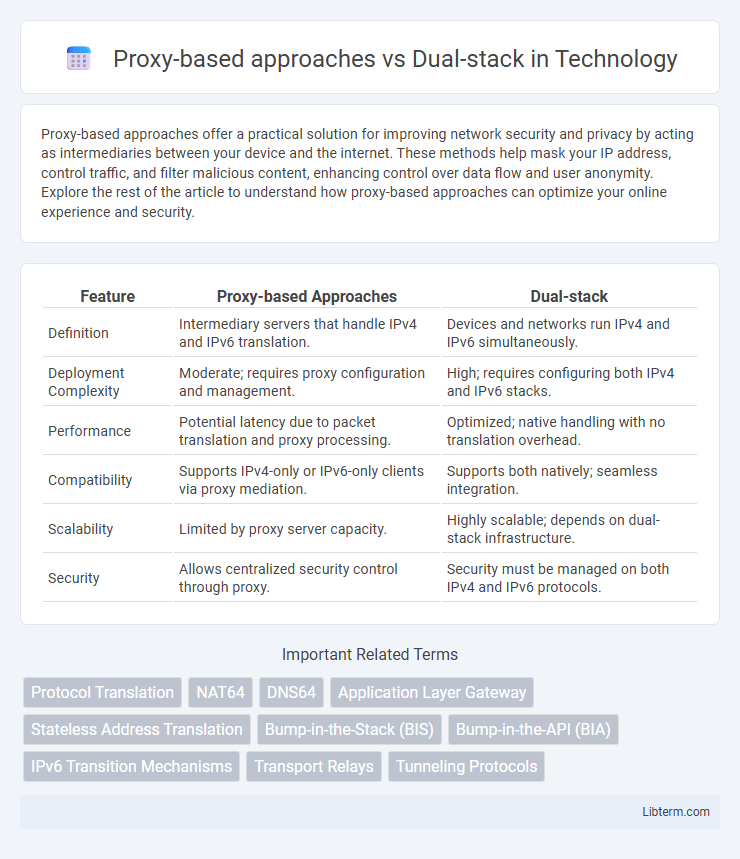Proxy-based approaches offer a practical solution for improving network security and privacy by acting as intermediaries between your device and the internet. These methods help mask your IP address, control traffic, and filter malicious content, enhancing control over data flow and user anonymity. Explore the rest of the article to understand how proxy-based approaches can optimize your online experience and security.
Table of Comparison
| Feature | Proxy-based Approaches | Dual-stack |
|---|---|---|
| Definition | Intermediary servers that handle IPv4 and IPv6 translation. | Devices and networks run IPv4 and IPv6 simultaneously. |
| Deployment Complexity | Moderate; requires proxy configuration and management. | High; requires configuring both IPv4 and IPv6 stacks. |
| Performance | Potential latency due to packet translation and proxy processing. | Optimized; native handling with no translation overhead. |
| Compatibility | Supports IPv4-only or IPv6-only clients via proxy mediation. | Supports both natively; seamless integration. |
| Scalability | Limited by proxy server capacity. | Highly scalable; depends on dual-stack infrastructure. |
| Security | Allows centralized security control through proxy. | Security must be managed on both IPv4 and IPv6 protocols. |
Introduction to Proxy-based Approaches and Dual-stack
Proxy-based approaches route internet traffic through intermediary servers that handle requests on behalf of clients, enhancing privacy and enabling content filtering or caching. Dual-stack technology allows devices to simultaneously run both IPv4 and IPv6 protocols, ensuring seamless network communication and compatibility during transitions. Comparing these methods highlights proxy-based approaches' role in security and control, while dual-stack emphasizes protocol interoperability and network evolution.
Fundamental Concepts: Proxy-based Approaches Explained
Proxy-based approaches operate by intermediating communication between clients and servers, effectively hiding the client's IP address while managing protocol translation and security. These systems handle requests at the application level, enabling seamless interoperability between IPv4 and IPv6 without requiring native dual-stack support on devices. By encapsulating and translating traffic, proxy-based methods simplify network transition, reduce the complexity of address management, and enhance control over traffic flows.
Understanding Dual-stack Networking
Dual-stack networking enables devices to run both IPv4 and IPv6 protocols simultaneously, allowing seamless communication across different network types. Proxy-based approaches act as intermediaries to translate or tunnel between IPv4 and IPv6, which can introduce latency and complexity. Understanding dual-stack deployment is essential for ensuring compatibility and smoother transition during IPv6 adoption without relying heavily on translation mechanisms.
Key Differences Between Proxy-based Approaches and Dual-stack
Proxy-based approaches route IPv6 traffic through an intermediary server that translates or tunnels packets to IPv4 networks, enhancing compatibility without requiring changes to end devices. Dual-stack enables devices and networks to run both IPv4 and IPv6 protocols concurrently, allowing direct native communication on either protocol. Key differences include proxy dependence on intermediary translation versus dual-stack's native protocol support, impacting latency, complexity, and deployment scalability.
Advantages of Proxy-based Approaches
Proxy-based approaches enhance network security by acting as intermediaries that filter and monitor traffic, effectively blocking malicious content and unauthorized access. They improve performance through caching frequently requested resources, reducing latency and bandwidth usage compared to dual-stack implementations. Moreover, proxies simplify IPv4 and IPv6 interoperability by translating address protocols without requiring changes to end-user devices or applications.
Benefits of Dual-stack Deployment
Dual-stack deployment enables simultaneous support for both IPv4 and IPv6, ensuring seamless connectivity across diverse networks and devices, which enhances compatibility and user experience. It eliminates the need for protocol translation or encapsulation inherent in proxy-based approaches, reducing latency and boosting network performance. This approach also simplifies network management by maintaining consistent routing and security policies across both protocols.
Performance Comparison: Proxy-based vs. Dual-stack
Proxy-based approaches introduce additional latency by routing traffic through intermediary servers, which can impact overall network performance and increase response times. Dual-stack implementations enable direct IPv4 and IPv6 communication, reducing overhead and improving transmission speed by avoiding extra hops through proxies. Performance metrics consistently show lower latency and higher throughput in dual-stack networks compared to proxy-based approaches, especially in real-time and bandwidth-intensive applications.
Security Implications: Proxy-based Approaches vs Dual-stack
Proxy-based approaches enhance security by isolating internal networks from external traffic, enabling in-depth inspection, filtering, and anonymization, which helps prevent unauthorized access and mitigate cyber threats. Dual-stack configurations expose devices to both IPv4 and IPv6 networks simultaneously, increasing the attack surface and complicating firewall rules, thereby raising the risk of security vulnerabilities and misconfigurations. Organizations prioritizing security often prefer proxy-based methods for tighter control over data flow and threat detection compared to the inherent risks associated with dual-stack deployments.
Use Cases and Optimal Scenarios
Proxy-based approaches excel in environments requiring transparent IPv4 to IPv6 translation, such as legacy application support and network address translation scenarios where seamless integration is critical. Dual-stack implementations are optimal for networks transitioning gradually to IPv6, enabling simultaneous operation and direct communication over both protocols without translation overhead. Use cases favor proxy-based solutions in controlled enterprise networks, while dual-stack suits broadband ISPs and mobile operators managing mixed IPv4/IPv6 traffic.
Future Trends in Network Transition Technologies
Proxy-based approaches enhance network security and privacy by masking original IP addresses, facilitating smooth IPv4 to IPv6 transition without requiring end-user device upgrades. Dual-stack technology supports simultaneous operation of IPv4 and IPv6, enabling gradual migration and compatibility across heterogeneous networks during the transition phase. Emerging trends indicate increased integration of AI-driven traffic management with proxy systems and optimization of dual-stack deployments to reduce latency and improve scalability in future network infrastructures.
Proxy-based approaches Infographic

 libterm.com
libterm.com